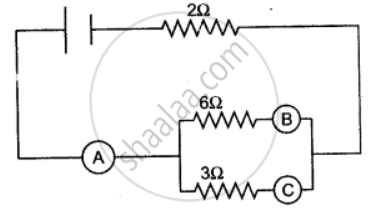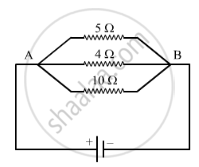Advertisements
Advertisements
Question
In the figure given below, A, B and C are three ammeters. The ammeter B reads 0.5A. (All the ammeters have negligible resistance.)

Calculate:
(i) the readings in the ammeters A and C.
(ii) the total resistance of the circuit.
Solution
(i) P.d. across 6 Ω = P. d. across 3 Ω
Or 6 × 0.5 = 3 × ic
Or ic i.e., current passing through the ammeter C is:
`(6 xx 0.5)/3 = 1.0`ampere
(ii) Here, `1/"R" = 1/6 + 1/3 = 3/6 = 1/2`
or R = 2 Ω
∴ Total ressistance of the circuit = 2Ω + R = 2Ω + 2Ω = 4Ω
∴ Current through A = Current passing through B + current passing through C
= 0.5 + 1.0 = 1.5 ampere
APPEARS IN
RELATED QUESTIONS
Calculate the quantity of heat produced in a 20 Ω resistor carrying 2.5 A current in 5 minutes.
Write down the formula which states the relation between potential difference, current, and resistance.
In the circuit diagram given below, the current flowing across 5 ohm resistor is 1 amp. Find the current flowing through the other two resistors.

Define the term ‘volt’.
The device used for measuring potential difference is
Define the following:
Potential difference
The voltage across a 3Ω resistance is 6 V. How large is the current? What is
the resistance of a filament lamp when a voltage of 3 V across it causes a
current of 0.5 A?
A 10 m long wire of a particular material is of reistance 5Ω What will be the resistance of 5m long wire of same material and the same thickness.
How will you conclude that the same potential difference (voltage) exists across three resistors connected in a parallel arrangement to a battery?
Name a device that helps to maintain a potential difference across conductors.
